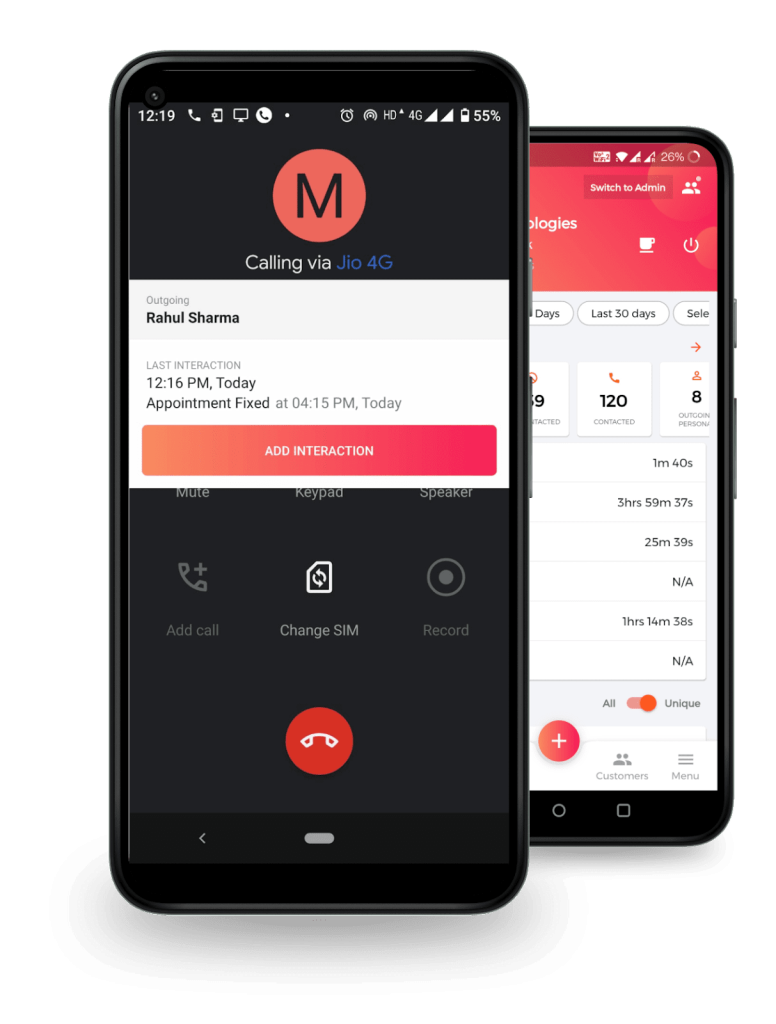In telemarketing, the battle between cloud telephony and SIM-based calling has been a topic of spirited discussion. While cloud telephony has gained significant traction for its cost-effective nature and advanced features, it is essential to recognize the power and reliability of SIM-based calling. This blog will dive deep into SIM-based calling, showcasing its exceptional qualities and how it can compete head-to-head with cloud telephony for telemarketing.
What is Cloud Calling?
Cloud calling is a way of making phone calls over the internet, instead of using a regular phone line. You don’t need to buy or install any equipment for your phone system, because everything is done by a company that provides cloud calling services.

Cloud calling works by using voice-over-internet protocol (VoIP) technology, which converts voice signals into digital data packets that can be transmitted over the internet. Cloud calling allows you to make and receive calls from anywhere, using any device, as long as you have an internet connection.
This platform revolutionized telemarketing by leveraging internet technology to transmit voice calls. It eliminated the need for physical infrastructure by adopting subscription-based pricing models.
When cloud-based calling first came out, it offered scalability as a key advantage, allowing businesses to easily adjust calling capacity based on demand. Cloud telephony provides advanced features such as call analytics, recording, auto-dialers, and more, improving performance and customer experiences.
The Case for SIM-Based Outbound Calling
In the ever-evolving landscape of telemarketing, it’s crucial to consider alternative approaches to communication. While cloud telephony has merits, SIM-based calling offers a compelling case for businesses looking to optimize their telemarketing efforts. Let’s explore the key differences between cloud telephony and SIM-based calling and uncover the advantages of the latter.
Introduction to SIM-Based Outbound Calling
SIM-based calling is a method that leverages traditional SIM cards used in mobile devices for voice calls. Unlike cloud telephony, which relies on internet connectivity, SIM-based calling operates through cellular networks.

Advantages of SIM-Based Calling over Cloud Calling System
Higher Contact Ratio
On SIM-based telecalling, you can witness an improved contact ratio with potential customers. This is due to the fact that the number used on a SIM is a regular phone number, unlike a landline number typically associated with cloud telephony. Businesses have witnessed a contact ratio of upwards of 78%, whereas else on cloud telephony systems it is 25%.
Super Easy Implementation
A SIM-based calling can be set up easily and does not require an expert to set it up. The process of setting up is DIY and can be done in the span of 15-20 mins. Additionally, it is also easy to set up call tracking on a mobile phone to track sales calls.
Pocket Friendly
While cloud telephony often demands significant upfront investment and ongoing subscription fees, SIM-based calling offers a cost-effective alternative. SIM-based can be set up with low investment and recurring costs can be as low as 1/4 compared to cloud telephony. By eliminating the need for expensive hardware and infrastructure associated with cloud telephony, businesses can save on substantial upfront costs.
Simple to Sale Up & Scale Down
Moreover, SIM-based calling offers the advantage of greater scalability for businesses. With SIM cards, companies can easily adjust their calling capacity by adding or removing cards as needed.
This flexibility enables them to efficiently scale their operations based on demand, ensuring they can handle a higher volume of calls during peak periods and reduce capacity during slower periods.
This scalability feature of SIM-based calling empowers businesses to optimize their resources effectively and maintain a smooth and uninterrupted customer communication experience.
Retain Existing Business Numbers
SIM-based telecalling offers a unique advantage – the ability to retain your existing business numbers without any changes. Unlike cloud telephony, where you often have to adopt new numbers provided by the service provider, SIM-based telecalling allows for seamless integration of your current contact information. This aspect holds significant value for businesses in terms of brand consistency and customer trust.
By preserving familiar business numbers, companies can ensure a smooth transition and uninterrupted communication with their clientele. On the other hand, cloud telephony often requires the use of different numbers, which can lead to confusion among customers who are accustomed to your previous contact details.
The ability to keep your business numbers intact while implementing SIM-based telecalling not only reinforces your brand identity but also maintains customer trust and facilitates efficient communication.

The case of SIM-Based Outbound calling
These are some of the advantages of SIM-Based calling over cloud-based telephony. Up until now, SIM-Based calling was not considered a good platform for telemarketing because earlier it was difficult to track all the calls made from a phone using SIM cards.
But now all that has changed because today we have Runo in the market.
Runo call management CRM has been a game changer for SIM-based telemarketing. As it combines the benefits of SIM-based calling with the feature set of Cloud-based phone systems.

Runo helps you manage calls at the SIM level & it comes with a comprehensive set of features like Auto Dialer, Track the live status of the team, add interaction pop-up, call recording, get real-time call analytics like call attempts, call connected, average call time, login time, break time and more.
It is hassle-free to start using Runo as has a DIY setup process. This telecaller app also has an intuitive user interface that requires no learning curve. Runo has all the essential features of the Telecalling app. With these features, managers can track the performance of each team member & help them optimize productivity.
Runo also has an in-built CRM for tracking customer journeys. It can also be integrated with dedicated CRM tools such as Zoho, Hubspot, and more. Additionally, you can also integrate Runo with lead source platforms like Facebook, website, and more. The generated leads automatically sync and also get automatically allocated to team members.
Existing customers of Runo have doubled their sales conversion in less than 30 days. And the contact ratio has been improved by more than 78%. These results demonstrate the tangible benefits and successes that businesses have achieved by adopting SIM-Based calling alongside Runo as their Call Management CRM tool.
Conclusion
SIM-Based calling emerges as the preferred platform for telemarketing, offering cost-effectiveness, flexibility, and local presence. When paired with a powerful Call Management CRM tool, businesses can optimize their telemarketing efforts, streamline customer interactions, and track performance metrics. With SIM-Based calling, businesses can achieve improved contact ratios, enhanced scalability, and reduced infrastructure costs, making it a compelling choice for organizations of all sizes.
Try out Runo for Free, the best telecalling app
Frequently Asked Question
What is the difference between VoIP and cloud telephony?
VoIP (Voice over Internet Protocol) and cloud telephony are related but distinct concepts. VoIP refers to the technology that enables voice communication over the internet. It converts analog voice signals into digital data packets and transmits them over IP networks. Cloud telephony, on the other hand, encompasses a broader set of services and features delivered through the cloud. It includes VoIP but goes beyond it, providing additional capabilities like call routing, virtual phone numbers, IVR, and more. In essence, VoIP is a component of cloud telephony, which encompasses a wider range of functionalities for telecommunication needs.
